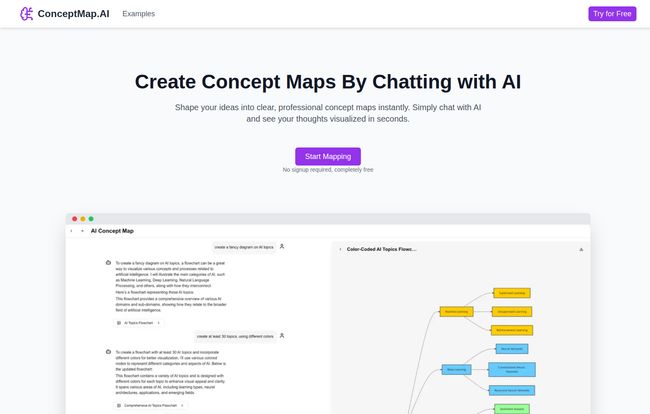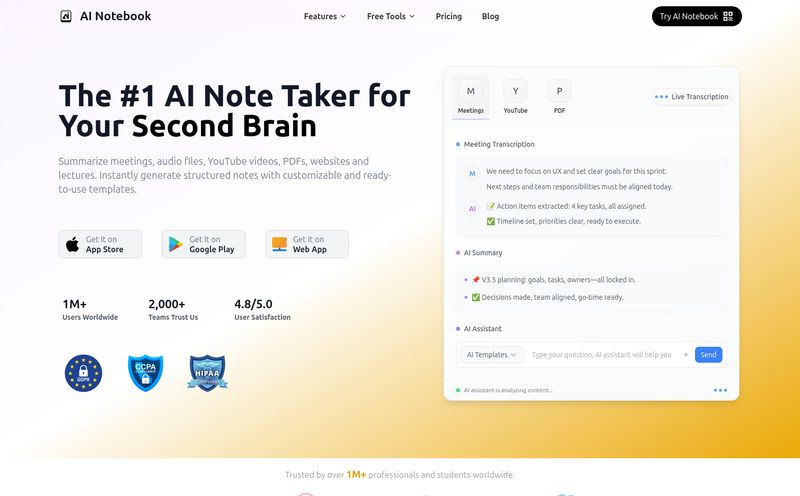We've all been there. Staring at a blank screen, a fresh whiteboard, or a new canvas in Miro, with a brain full of brilliant, chaotic ideas. You know the connections are there, somewhere, buried under a pile of mental clutter. So you start dragging boxes, drawing lines, trying to wrestle your thoughts into some semblance of order. An hour later, you have a messy web that looks more like a conspiracy theorist's corkboard than a coherent plan.
It's the classic paradox of brainstorming tools: they're supposed to help you organize your thoughts, but sometimes they just add another layer of work. You become a node-manager, a line-drawer, a color-coder. The tool gets in the way of the thinking.
But what if you could just… talk it out? What if you could describe your ideas to an assistant, and they'd sketch it out for you, live? That’s the promise of a new wave of AI tools, and one that recently caught my eye is ConceptMap.AI. I've spent the last week kicking its tires, and I have some thoughts.
So, What Exactly is ConceptMap.AI?
At its heart, ConceptMap.AI is a concept and mind map generator that swaps the drag-and-drop interface for a chatbot. Instead of you manually building a diagram, you have a conversation with an AI about your topic. You feed it ideas, it asks clarifying questions, and it builds a professional-looking visual map in real time.
Think of it less like a drawing tool and more like a Socratic partner who also happens to be a swift graphic designer. It’s built for what they call “knowledge workers”—a term I both love and hate—but it's clearly perfect for students, researchers, content creators, and anyone who needs to untangle complex information without getting a headache. You just start typing, and the map begins to grow. It’s a little bit like magic.

Visit ConceptMap AI
My First Impressions: A Walkthrough of the Chat-to-Map Experience
The first thing that struck me was the lack of friction. You land on their site, and there’s the chat box, ready to go. No immediate “Create Your Account!” wall, no credit card required for a trial. I love that. In an age of endless subscriptions, just letting me try the thing is a massive green flag.
To put it through its paces, I decided to map out a content strategy for a new (hypothetical) client who sells artisanal coffee. I started simple:
“I'm creating a content marketing plan for a specialty coffee brand. The main goal is to increase brand awareness among coffee enthusiasts.”
Instantly, a central node appeared: “Content Marketing Plan for Specialty Coffee.” Then, a connecting node: “Goal: Increase Brand Awareness.” Okay, pretty basic. But then I kept talking to it.
“Let's break that down into three pillars: Blog Content, Social Media, and a Newsletter.”
Boom. Three branches shot out from the main topic. The AI then prompted me, asking what kind of blog content I was thinking of. I listed a few ideas: “Brewing guides, coffee bean origin stories, and interviews with roasters.” Each one became a sub-node, perfectly organized. The “Instant Visualization” feature is no joke. It's not literally a millisecond, but it’s fast enough that it feels like the map is an extension of your conversation.
The really interesting part is the customization. Instead of hunting for a formatting toolbar, you just ask. “Can you make the ‘Social Media’ branch blue?” Done. “Connect the ‘interviews with roasters’ idea to a new node called ‘Partnership Opportunities’.” The AI understood the relationship and drew the connection. It felt incredibly natural, like I was directing an actual assistant.
The Good, The Bad, and The AI-Powered
No tool is perfect, of course. After using it for several projects, from mapping out this very article to brainstorming a home renovation, here’s my honest breakdown.
What I Absolutely Love
The biggest win here is the conversational flow. It completely shatters the “blank canvas paralysis” that can stop a brainstorming session before it even starts. The act of writing or speaking your ideas forces you to articulate them, and the AI acts as a perfect sounding board. This is, without a doubt, its killer feature.
The speed is another huge plus. I’ve spent hours in other tools trying to get spacing right and making sure lines don’t overlap weirdly. With ConceptMap.AI, I went from a jumble of notes to a clean, shareable diagram in about 15 minutes. For quick ideation, that’s unbeatable. And the one-click sharing means I can send a link to a colleague for feedback without them needing an account. Simple, effective.
Where It Could Be Better
Here’s the trade-off: you give up a significant amount of granular control. As someone who can be a bit of a perfectionist, I found myself occasionally wishing I could just grab a node and nudge it two pixels to the left. You have to trust the AI's aesthetic choices. For 90% of cases, it’s fine. But for that final 10% of presentation-level polish, you might feel a little constrained.
Then there are the inevitable data privacy jitters. Their FAQ is very clear: “Your data is processed securely, not stored permanently, and never used to train our models without consent.” This is exactly what you want to hear. Still, with any cloud-based AI tool, especially a newer one, I’d be cautious. I’m not pasting in super-sensitive corporate strategy or personal financial data just yet. It’s a general rule of thumb for any new AI platform, not just a knock on this one.
Lastly, it’s not a replacement for something like Lucidchart or Visio if you need highly technical, advanced diagrams with specific notations or data linking. It excels at the ideation and organization phase, not the hyper-detailed execution phase.
Let's Talk Money: Is ConceptMap.AI Really Free?
Ah, the age-old question. The homepage proudly states it’s a “free AI concept map maker” and that no signup is required. And that's true... to a point. It operates on a freemium model, which is pretty standard stuff.
The Free plan is essentially a very generous, ongoing trial. You get 10 chats per day, which is more than enough to figure out if you like the workflow or to map out a quick idea. However, you have limited access to the AI models and chat length. It’s a fantastic starting point.
If you become a power user, you’ll want to look at the Premium plan. This unlocks everything: unlimited chats, access to the more advanced AI models, priority support, and early access to new features. Here’s how the pricing breaks down:
| Plan Type | Effective Monthly Cost | Billing Cycle |
|---|---|---|
| Monthly | $9.90 | Billed monthly |
| Semi-Annually | $6.65 | Billed $39.90 every 6 months |
| Annually (Best Value) | $4.99 | Billed $59.90 every 12 months |
In my opinion, the annual plan at $4.99 a month is a pretty great deal if you find yourself using this regularly. That’s less than two fancy coffees a month to have a brainstorming assistant on call 24/7. The monthly plan is better if you just need to grind through a single, intensive project for a few weeks. They also offer a 3-day money-back guarantee on the premium plans, so the risk is low.
Who Should Use ConceptMap.AI? (And Who Might Want to Stick With Their Old Tools?)
This tool isn’t going to be for everyone, and that's okay. It shines brightest for a specific type of user and task.
This is a fantastic tool for:
- Students: Quickly organizing lecture notes, planning essays, and studying for exams. The conversational method is great for reinforcing knowledge.
- Content Creators & Marketers: Mapping out articles, video scripts, social media campaigns, or entire content funnels.
- Consultants & Coaches: Visually structuring client problems and collaboratively brainstorming solutions during a call.
- Anyone in the early ideation stage: If you're a founder, product manager, or researcher just trying to get a flood of ideas out of your head and into a structured format, this is your new best friend.
You might want to look elsewhere if:
- You're a designer or visual artist who needs pixel-perfect control over your diagrams.
- You're a project manager who needs a tool with integrated Gantt charts, task dependencies, and resource management (like Asana or ClickUp).
- Your work involves creating highly technical, standardized diagrams like UML or network architecture maps.
The Verdict: A Refreshing New Way to Brainstorm
ConceptMap.AI is a genuinely innovative take on a decades-old problem. It successfully removes the friction of manual diagramming and makes brainstorming faster, more fluid, and more intuitive. The conversational interface is its true superpower, turning the daunting task of organizing thoughts into a simple, productive chat.
Yes, you sacrifice some manual control, and yes, it’s not designed for every type of complex diagramming. But for its intended purpose—helping you think, organize, and visualize ideas quickly—it’s brilliant. It's found a permanent spot in my personal SEO toolkit for initial content planning and strategy sessions.
Given the generous free plan, there’s really no reason not to give it a spin. Go talk your next big idea into existence. You might be surprised at how clearly you can see it.
Frequently Asked Questions
What exactly is ConceptMap.AI?
It's an AI-powered tool that lets you create concept maps, mind maps, and flowcharts by having a conversation with a chatbot. Instead of dragging and dropping elements, you describe your ideas, and the AI visualizes them for you in real-time.
Is ConceptMap.AI actually free to use?
Yes, it has a free plan that is quite useful. It allows for 10 chats per day, which is great for trying it out or for occasional use. For unlimited usage and more advanced features, you'll need to subscribe to their Premium plan.
Can I customize the maps I create?
Yes, but you do it through conversation. You can ask the AI to change colors, restructure connections, add or remove nodes, and rephrase text. You don't have the manual, granular control of traditional tools, but the chat-based customization is surprisingly flexible.
How is my data handled? Is it secure?
According to their website, ConceptMap.AI processes your data securely. They state that data is not stored permanently and is never used to train their AI models without your explicit consent, which is a strong privacy stance.
What kinds of diagrams can I make?
It's quite versatile. You can create concept maps, mind maps, flowcharts, spider maps, system maps, argument maps, and more. It's best for visualizing relationships between ideas and organizing information hierarchies.
Who is the ideal user for ConceptMap.AI?
It's perfect for anyone who does a lot of brainstorming and organizing of ideas: students, writers, marketers, researchers, consultants, and project managers in the ideation phase. If your main goal is to get thoughts out of your head and into a structure quickly, it's an excellent fit.
References and Sources
- ConceptMap.AI Official Website
- ConceptMap.AI Pricing Page
- Miro (For comparison of a traditional, canvas-based tool)



